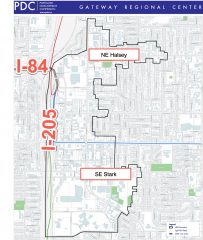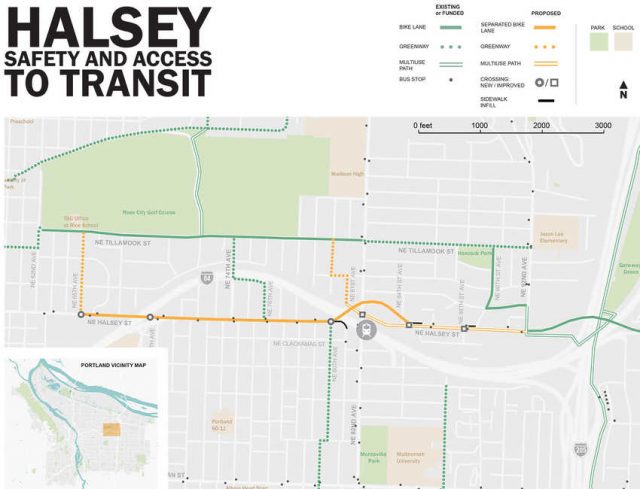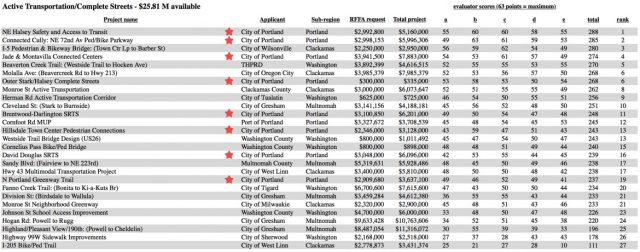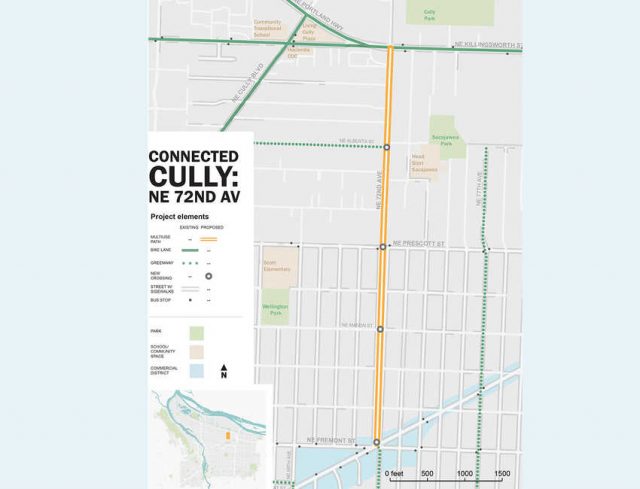The Cully neighborhood would get a new biking and walking “parkway” and big roads that run through two major commercial districts in east Portland near I-205 could be updated and vastly improved for people on bikes and foot if the City of Portland is able to convince Metro to give them the cash to do it.
A $130 million pot of federal funding is up for grabs through Metro’s “regional flexible funding” program. Of that amount, $33 million is up for transportation projects. Unlike most federal funds, RFF money isn’t tied to the federal gas tax and can be spent on a wide variety of projects — including infrastructure that makes it easier to walk and roll.
The 31 proposed projects — four in the freight category where there’s $7.3 million available and 27 in the active transportation category where there’s $25.8 million available — come from pre-existing lists put together by cities and counties throughout the region. A committee at Metro has already given each project a technical ranking and PBOT has earned gold and silver: Their plan to update NE Halsey street and make it easier to walk and roll to the 82nd Avenue MAX light rail station is ranked #1 and their “walking and biking parkway” through the Cully neighborhood on NE 72nd is ranked #2.
Here’s the entire list with final rankings on the right (I’ve put a star next to PBOT’s projects):
The Halsey project is estimated to cost $5.1 million total (PBOT is requesting $3 million from Metro) and would build a new separated bike lane from 65th to 83rd, a neighborhood greenway connection between Tillamook and Halsey along 65th and 81st, and a new multi-use path that would connect 81st (at Halsey) to a new path over I-205 near Gateway Green.
The $6 million Cully Parkway project (PBOT is asking Metro for half that amount) would build a multi-use path on both sides the west side of NE 72nd Avenue from Killingsworth to Fremont.
If funded, the City’s NE Halsey Safety and Access to Transit project would be just the latest bit of good news for this currently auto-centric “high crash corridor.” As we reported last month, PBOT has a shovel-ready project to redesign outer Halsey with buffered bike lanes and new sidewalks between 122nd and the Gresham border. In between these two City projects, the Portland Development Commission has already announced plans to build protected bikeways on the Halsey-Weidler couplet just east of I-205, making it one of the bike-friendliest commercial streets in the entire city.
Advertisement

In addition to the changes on Halsey, PBOT has also requested $300,000 to further develop these projects and do public outreach not just on Halsey but further south on Stark Street as well. Among the goals of their Outer Stark/Halsey Complete Streets project is an, “Evaluation of alternative cross-sections for all roadway segments and major intersection approaches to determine optimal allocation of right-of-way between medians, turn lanes, median islands, travel lanes, bike lanes, sidewalks, parking, etc.” This is the type of outreach and analysis they need to do prior creating concrete designs for significant streetscape changes (like the ones planned for Halsey) in the future. This project has been ranked sixth out of the 27 flexible fund project candidates.
(Note: Both the Halsey-Weidler couplet and the Stark-Washington couplet are part of the PDC’s Gateway Regional Center urban renewal area.)
The key to these strong rankings isn’t just because these projects would improve safety for everyone, it’s because they would do it in a place with above average concentrations of low-income, elderly, and non-white households. “Residents of these communities, many of whom have limited or no access to motor vehicles, and some of whom had been displaced from inner Portland neighborhoods with better active transportation infrastructure,” reads PBOT’s grant application, “will benefit from the ultimately constructed project by having access to safer infrastructure for walking, bicycling and accessing transit.”
If you like the sound of these projects, now is the time to comment. Metro has a great interactive comment map where you can learn more about all the projects. You can also email transportation@oregonmetro.gov or come to a public hearing at 4:00 pm on October 27th at Metro headquarters (600 NE Grand Ave). To see the full project grant applications and learn more about regional flexible funds, see this page at OreognMetro.gov.
— Jonathan Maus, (503) 706-8804 – jonathan@bikeportland.org
BikePortland is supported by the community (that means you!). Please become a subscriber or make a donation today.




